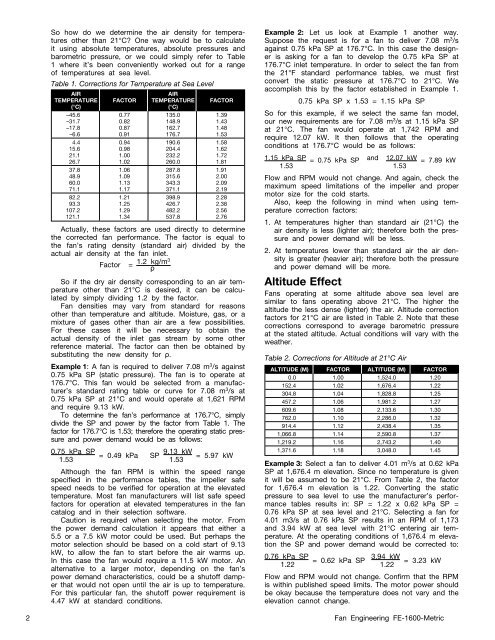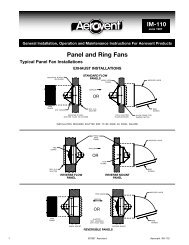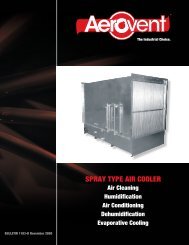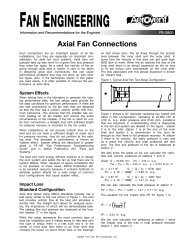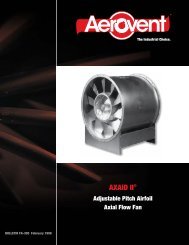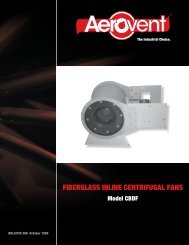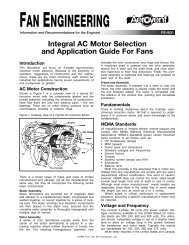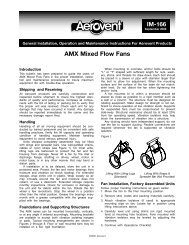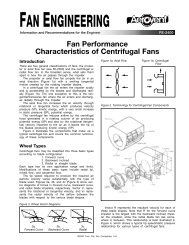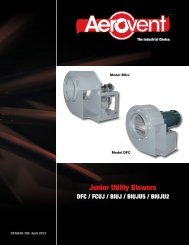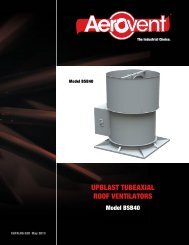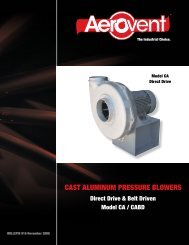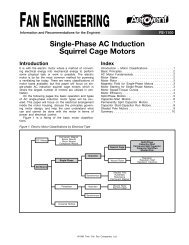Temperature and Altitude Effects on Fans - Aerovent
Temperature and Altitude Effects on Fans - Aerovent
Temperature and Altitude Effects on Fans - Aerovent
You also want an ePaper? Increase the reach of your titles
YUMPU automatically turns print PDFs into web optimized ePapers that Google loves.
So how do we determine the air density for temperaturesother than 21°C? One way would be to calculateit using absolute temperatures, absolute pressures <str<strong>on</strong>g>and</str<strong>on</strong>g>barometric pressure, or we could simply refer to Table1 where it’s been c<strong>on</strong>veniently worked out for a rangeof temperatures at sea level.Table 1. Correcti<strong>on</strong>s for <str<strong>on</strong>g>Temperature</str<strong>on</strong>g> at Sea LevelAIRAIRTEMPERATURE FACTOR TEMPERATURE FACTOR(°C)(°C)–45.6 0.77 135.0 1.39–31.7 0.82 148.9 1.43–17.8 0.87 162.7 1.48–6.6 0.91 176.7 1.534.4 0.94 190.6 1.5815.6 0.98 204.4 1.6221.1 1.00 232.2 1.7226.7 1.02 260.0 1.8137.8 1.06 287.8 1.9148.9 1.09 315.6 2.0060.0 1.13 343.3 2.0971.1 1.17 371.1 2.1982.2 1.21 398.9 2.2893.3 1.25 426.7 2.38107.2 1.29 482.2 2.56121.1 1.34 537.8 2.76Actually, these factors are used directly to determinethe corrected fan performance. The factor is equal tothe fan’s rating density (st<str<strong>on</strong>g>and</str<strong>on</strong>g>ard air) divided by theactual air density at the fan inlet.Factor =1.2 kg/m3ρSo if the dry air density corresp<strong>on</strong>ding to an air temperatureother than 21°C is desired, it can be calculatedby simply dividing 1.2 by the factor.Fan densities may vary from st<str<strong>on</strong>g>and</str<strong>on</strong>g>ard for reas<strong>on</strong>sother than temperature <str<strong>on</strong>g>and</str<strong>on</strong>g> altitude. Moisture, gas, or amixture of gases other than air are a few possibilities.For these cases it will be necessary to obtain theactual density of the inlet gas stream by some otherreference material. The factor can then be obtained bysubstituting the new density for ρ.Example 1: A fan is required to deliver 7.08 m 3 /s against0.75 kPa SP (static pressure). The fan is to operate at176.7°C. This fan would be selected from a manufacturer’sst<str<strong>on</strong>g>and</str<strong>on</strong>g>ard rating table or curve for 7.08 m 3 /s at0.75 kPa SP at 21°C <str<strong>on</strong>g>and</str<strong>on</strong>g> would operate at 1,621 RPM<str<strong>on</strong>g>and</str<strong>on</strong>g> require 9.13 kW.To determine the fan’s performance at 176.7°C, simplydivide the SP <str<strong>on</strong>g>and</str<strong>on</strong>g> power by the factor from Table 1. Thefactor for 176.7°C is 1.53; therefore the operating static pressure<str<strong>on</strong>g>and</str<strong>on</strong>g> power dem<str<strong>on</strong>g>and</str<strong>on</strong>g> would be as follows:0.75 kPa SP 9.13 kW = 0.49 kPa SP = 5.97 kW1.53 1.53Although the fan RPM is within the speed rangespecified in the performance tables, the impeller safespeed needs to be verified for operati<strong>on</strong> at the elevatedtemperature. Most fan manufacturers will list safe speedfactors for operati<strong>on</strong> at elevated temperatures in the fancatalog <str<strong>on</strong>g>and</str<strong>on</strong>g> in their selecti<strong>on</strong> software.Cauti<strong>on</strong> is required when selecting the motor. Fromthe power dem<str<strong>on</strong>g>and</str<strong>on</strong>g> calculati<strong>on</strong> it appears that either a5.5 or a 7.5 kW motor could be used. But perhaps themotor selecti<strong>on</strong> should be based <strong>on</strong> a cold start of 9.13kW, to allow the fan to start before the air warms up.In this case the fan would require a 11.5 kW motor. Analternative to a larger motor, depending <strong>on</strong> the fan’spower dem<str<strong>on</strong>g>and</str<strong>on</strong>g> characteristics, could be a shutoff damperthat would not open until the air is up to temperature.For this particular fan, the shutoff power requirement is4.47 kW at st<str<strong>on</strong>g>and</str<strong>on</strong>g>ard c<strong>on</strong>diti<strong>on</strong>s.Example 2: Let us look at Example 1 another way.Suppose the request is for a fan to deliver 7.08 m 3 /sagainst 0.75 kPa SP at 176.7°C. In this case the designeris asking for a fan to develop the 0.75 kPa SP at176.7°C inlet temperature. In order to select the fan fromthe 21°F st<str<strong>on</strong>g>and</str<strong>on</strong>g>ard performance tables, we must firstc<strong>on</strong>vert the static pressure at 176.7°C to 21°C. Weaccomplish this by the factor established in Example 1.0.75 kPa SP x 1.53 = 1.15 kPa SPSo for this example, if we select the same fan model,our new requirements are for 7.08 m 3 /s at 1.15 kPa SPat 21°C. The fan would operate at 1,742 RPM <str<strong>on</strong>g>and</str<strong>on</strong>g>require 12.07 kW. It then follows that the operatingc<strong>on</strong>diti<strong>on</strong>s at 176.7°C would be as follows:1.15 kPa SP = 0.75 kPa SP <str<strong>on</strong>g>and</str<strong>on</strong>g> 12.07 kW = 7.89 kW1.53 1.53Flow <str<strong>on</strong>g>and</str<strong>on</strong>g> RPM would not change. And again, check themaximum speed limitati<strong>on</strong>s of the impeller <str<strong>on</strong>g>and</str<strong>on</strong>g> propermotor size for the cold starts.Also, keep the following in mind when using temperaturecorrecti<strong>on</strong> factors:1. At temperatures higher than st<str<strong>on</strong>g>and</str<strong>on</strong>g>ard air (21°C) theair density is less (lighter air); therefore both the pressure<str<strong>on</strong>g>and</str<strong>on</strong>g> power dem<str<strong>on</strong>g>and</str<strong>on</strong>g> will be less.2. At temperatures lower than st<str<strong>on</strong>g>and</str<strong>on</strong>g>ard air the air densityis greater (heavier air); therefore both the pressure<str<strong>on</strong>g>and</str<strong>on</strong>g> power dem<str<strong>on</strong>g>and</str<strong>on</strong>g> will be more.<str<strong>on</strong>g>Altitude</str<strong>on</strong>g> Effect<strong>Fans</strong> operating at some altitude above sea level aresimilar to fans operating above 21°C. The higher thealtitude the less dense (lighter) the air. <str<strong>on</strong>g>Altitude</str<strong>on</strong>g> correcti<strong>on</strong>factors for 21°C air are listed in Table 2. Note that thesecorrecti<strong>on</strong>s corresp<strong>on</strong>d to average barometric pressureat the stated altitude. Actual c<strong>on</strong>diti<strong>on</strong>s will vary with theweather.Table 2. Correcti<strong>on</strong>s for <str<strong>on</strong>g>Altitude</str<strong>on</strong>g> at 21°C AirALTITUDE (M) FACTOR ALTITUDE (M) FACTOR0.0 1.00 1,524.0 1.20152.4 1.02 1,676.4 1.22304.8 1.04 1,828.8 1.25457.2 1.06 1,981.2 1.27609.6 1.08 2,133.6 1.30762.0 1.10 2,286.0 1.32914.4 1.12 2,438.4 1.351,066.8 1.14 2,590.8 1.371,219.2 1.16 2,743.2 1.401,371.6 1.18 3,048.0 1.45Example 3: Select a fan to deliver 4.01 m 3 /s at 0.62 kPaSP at 1,676.4 m elevati<strong>on</strong>. Since no temperature is givenit will be assumed to be 21°C. From Table 2, the factorfor 1,676.4 m elevati<strong>on</strong> is 1.22. C<strong>on</strong>verting the staticpressure to sea level to use the manufacturer’s performancetables results in: SP = 1.22 x 0.62 kPa SP =0.76 kPa SP at sea level <str<strong>on</strong>g>and</str<strong>on</strong>g> 21°C. Selecting a fan for4.01 m3/s at 0.76 kPa SP results in an RPM of 1,173<str<strong>on</strong>g>and</str<strong>on</strong>g> 3.94 kW at sea level with 21°C entering air temperature.At the operating c<strong>on</strong>diti<strong>on</strong>s of 1,676.4 m elevati<strong>on</strong>the SP <str<strong>on</strong>g>and</str<strong>on</strong>g> power dem<str<strong>on</strong>g>and</str<strong>on</strong>g> would be corrected to:0.76 kPa SP 3.94 kW = 0.62 kPa SP = 3.23 kW1.22 1.22Flow <str<strong>on</strong>g>and</str<strong>on</strong>g> RPM would not change. C<strong>on</strong>firm that the RPMis within published speed limits. The motor power shouldbe okay because the temperature does not vary <str<strong>on</strong>g>and</str<strong>on</strong>g> theelevati<strong>on</strong> cannot change.2Fan Engineering FE-1600-Metric


